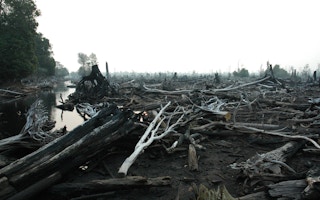Restoring Indonesia’s tropical peatlands is a cost-effective strategy to reduce the impacts of fires tearing through the carbon-rich soil, a new study says.
The benefits of effective peatland restoration — blocking drainage canals to restore water levels and reestablishing vegetation cover — will outweigh the cost of restoration, according to the peer-reviewed paper published in the journal Nature Communications on Dec. 2. The study authors calculate that peatland restoration could have resulted in economic savings of $8.4 billion between 2004 and 2015, when the six largest fire events in the country caused a total of $93.9 billion in economic losses. In addition to the damage to plantations, forestry and agriculture, the burning of the peatlands also resulted in massive volumes of CO2 emissions and adverse health effects for residents exposed to the haze from the fires.
Since the particularly severe fires of 2015, the administration of President Joko Widodo has earmarked up to $7 billion to restore 2.5 million hectares (6.2 million acres) of degraded peatland across the archipelago. These ecosystems hold an estimated 57 million metric tons of carbon, or roughly 55 per centof the world’s tropical peatland carbon. Since 2011 there’s also been a moratorium on converting peatlands for new developments.
“There is clearly a worldwide benefit to restoring and safeguarding Indonesian peatlands,” Laura Kiely, lead author of the new study and a doctoral researcher at the University of Leeds in the UK, said in a statement.
The researchers used satellite data and models to estimate that, if completed, peatland restoration would have contributed to significant reductions for 2004-2015 in fire losses and damages (9 per cent), CO2 emissions (46 per cent), PM2.5 emissions (54 per cent), health-related losses (30 per cent), and land-cover losses (24 per cent). The World Bank suggests that restoring 2 million hectares (4.9 million acres) of peatland would cost $1.9 billion; another study estimates that restoration costs would exceed $4.6 billion.
“Using either value, the cost associated with restoring peatland is less than the associated reduction in fire-related costs,” the authors write in the paper.
They noted that randomly allocating the 2.5 million hectares of restoration reduced emission reductions by more than half, demonstrating the importance of prioritising areas for peatland restoration. They recommend restoring peatlands with the greatest emissions of PM2.5 over 2004-2015, as carbon emissions are greatest the first time a peatland burns and typically decline with subsequent fires.
“Restoring unburned peatlands in areas of high fire risk will therefore lead to the greatest reduction in emissions,” the paper says.
The authors also highlighted the importance of preventing degradation of intact peatlands. Indonesia has a moratorium on cutting primary forest, but this only covers 32 per centof the country’s peatlands, leaving large swaths unprotected.
Fires lit to clear land can burn out of control and spread into degraded forests and peatlands, particularly during drought. Deforestation and drainage associated with expanding agriculture have caused extensive destruction to Indonesian peatlands, making the naturally fire-resilient landscapes more susceptible to fire. Fires are more likely to occur on degraded land than in protected areas of forest, and the use of drainage canals in agriculture can make fires nearly five times as likely.
Kiely said the findings were presented at the COP26 climate summit in Glasgow, Scotland, in November. The team also plans to show them to the Indonesian government in the near future, with the aim of encouraging continued support for the government’s Peatland and Mangrove Restoration Agency, which has been tasked with restoring and rewetting degraded peatlands, and for investors to provide financing for peatland restoration projects. Kiely added that local communities must be involved closely in peatland restoration to ensure they benefit.
“Future climate change will put Indonesian peatlands — and peatlands all over the world — at greater risk of further degradation and fire,” study co-author Dominick Spracklen from the University of Leeds said in the statement. “The efforts being made by the Indonesian government to restore their peatlands could be a leading example in the years to come.”
This story was published with permission from Mongabay.com.

















